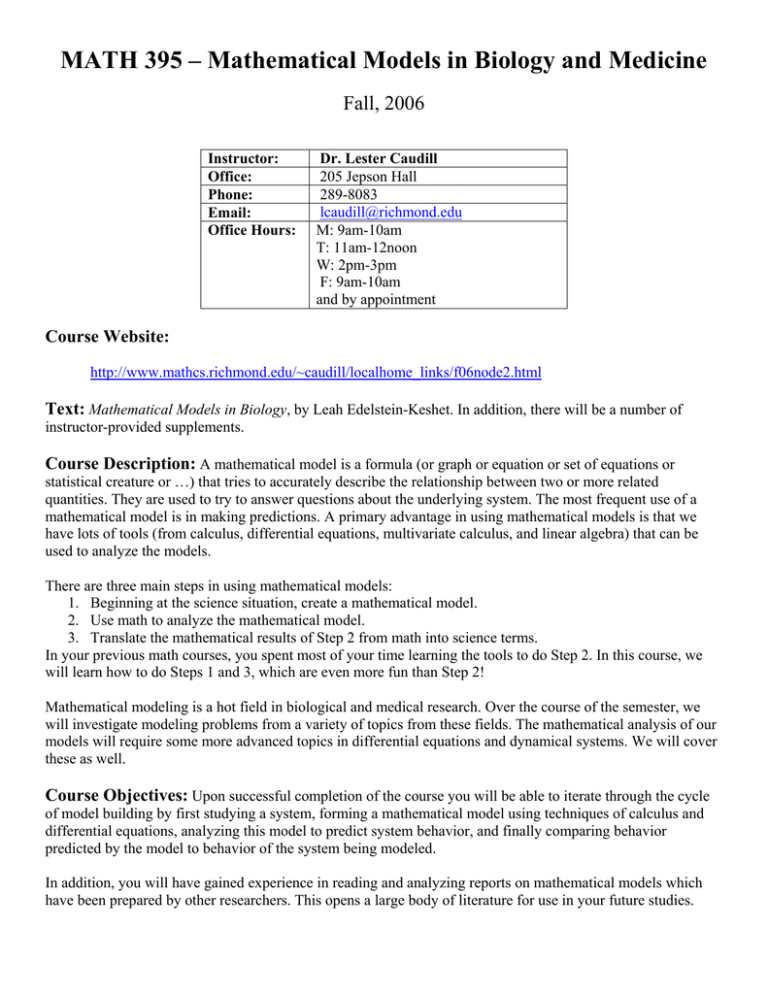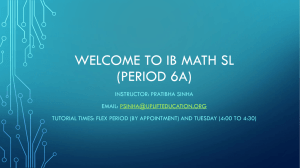MATH 395 – Mathematical Models in Biology and Medicine Fall, 2006 Text:
advertisement

MATH 395 – Mathematical Models in Biology and Medicine Fall, 2006 Instructor: Office: Phone: Email: Office Hours: Dr. Lester Caudill 205 Jepson Hall 289-8083 lcaudill@richmond.edu M: 9am-10am T: 11am-12noon W: 2pm-3pm F: 9am-10am and by appointment Course Website: http://www.mathcs.richmond.edu/~caudill/localhome_links/f06node2.html Text: Mathematical Models in Biology, by Leah Edelstein-Keshet. In addition, there will be a number of instructor-provided supplements. Course Description: A mathematical model is a formula (or graph or equation or set of equations or statistical creature or …) that tries to accurately describe the relationship between two or more related quantities. They are used to try to answer questions about the underlying system. The most frequent use of a mathematical model is in making predictions. A primary advantage in using mathematical models is that we have lots of tools (from calculus, differential equations, multivariate calculus, and linear algebra) that can be used to analyze the models. There are three main steps in using mathematical models: 1. Beginning at the science situation, create a mathematical model. 2. Use math to analyze the mathematical model. 3. Translate the mathematical results of Step 2 from math into science terms. In your previous math courses, you spent most of your time learning the tools to do Step 2. In this course, we will learn how to do Steps 1 and 3, which are even more fun than Step 2! Mathematical modeling is a hot field in biological and medical research. Over the course of the semester, we will investigate modeling problems from a variety of topics from these fields. The mathematical analysis of our models will require some more advanced topics in differential equations and dynamical systems. We will cover these as well. Course Objectives: Upon successful completion of the course you will be able to iterate through the cycle of model building by first studying a system, forming a mathematical model using techniques of calculus and differential equations, analyzing this model to predict system behavior, and finally comparing behavior predicted by the model to behavior of the system being modeled. In addition, you will have gained experience in reading and analyzing reports on mathematical models which have been prepared by other researchers. This opens a large body of literature for use in your future studies. Tablet PCs and DyKnow: Each day in class, we will use a special computer program called DyKnow (which is short for “Dynamic Knowledge Transfer”). Each member of the class will have access to a tablet PC, with DyKnow installed, during class-time. Among other things, this program will take your class notes for you, so you can focus on understanding the lesson, instead of worrying about writing every single word and chalkstroke. THIS IS A VERY GOOD THING! Project: Working in teams, students will complete a major modeling project, submit a written report, and give a brief yet stunning presentation to the class. Students will choose from a list of project ideas, or propose their own project. Presentations will be given during the last week of classes. Assignments: There will be two types of outside-of-class work in this course: • • Homework problems: Exercises which will be graded and returned for discussion. Modeling assignments: Models which you will design, analyze, and test, based on a general description of a problem. As the semester progresses, the size and difficulty of the modeling problems will increase. Computer Work: The availability of computer software packages provides today's scientist with a powerful tool for use in analyzing and testing mathematical models. A number of assignments will involve the use of the computer software packages Mathematica and Microsoft Excel. No special knowledge of computers is necessary for the course. Exams: There will be an in-class exam and a (take-home) final exam. The exams are scheduled to be administered/distributed on the following dates: • Midterm Exam (In-class): To Be Announced. • Final Exam (Take-home): Due by 5:00pm on Monday, December 18 Collaboration: As noted above, there will be two types of outside work: homework problems and modeling assignments. Students are permitted (and sometimes encouraged) to consult with one another on homework problems, provided everyone does their share. However, unless explicitly stated otherwise, each modeling assignment must be completed individually, and will be pledged under the Honor Code. Collaboration on exams, of course, is not permitted. Grading Policy: • • • • Homework/Classwork/Models: 30% Mid-term Exam: 20% Project/Presentation: 20% Final Exam: 30% Attendance: Students are expected to attend all class meetings and participate in class discussions and activities. Academic Honesty: Students are to abide by the official University policy on academic honesty. Each student will be required to sign all relevant work, thereby signifying their compliance with the University Honor Pledge.







